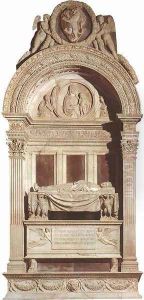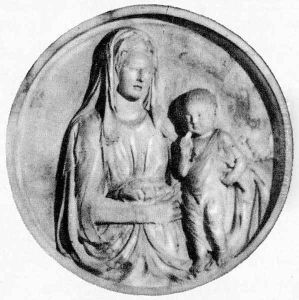Bernardo Rossellino Paintings
Bernardo Rossellino, born Bernardo di Matteo Gamberelli in 1409, was a prominent figure in the early Renaissance period, primarily renowned for his contributions to architecture and sculpture. A native of Settignano, near Florence, Italy, Rossellino was deeply influenced by the artistic milieu of Florence, a city at the heart of the Renaissance movement. He was the younger brother of Antonio Rossellino, also a noted sculptor, and it was within this environment rich in artistic fervor that Bernardo honed his craft.
Rossellino's work was significantly influenced by the pioneering architect and sculptor, Filippo Brunelleschi, and he is often associated with the development of Renaissance architecture. One of his most celebrated architectural works is the design of the Palazzo Piccolomini in Pienza, Italy, commissioned by Pope Pius II. This building is regarded as a masterpiece of early Renaissance architecture, embodying the principles of harmony, proportion, and perspective that were central to the Renaissance aesthetic. Moreover, Rossellino played a crucial role in the construction of the cathedral of Pienza, further cementing his reputation as a skilled architect.
As a sculptor, Bernardo Rossellino demonstrated versatility and innovation, contributing significantly to the realm of funerary monuments. His most notable work in this area is the tomb of Leonardo Bruni in the Church of Santa Croce, Florence. This monument is celebrated for its harmonious integration of architectural elements with sculptural figures, demonstrating Rossellino's mastery of both disciplines. The tomb's design reflects the humanist ideals of the period, with its classical form and emphasis on individual achievement.
Rossellino's influence extended beyond his immediate contributions to architecture and sculpture. His works embodied the ideals of the Renaissance, merging classical forms with a humanist spirit, and his approach to design and aesthetics had a lasting impact on subsequent generations of artists and architects. Despite his significant contributions, Rossellino's work was, for a time, overshadowed by that of his contemporaries. However, modern scholarship has recognized his role in shaping the visual landscape of the Renaissance.
Bernardo Rossellino's career was a testament to the vibrant artistic culture of 15th-century Italy, and his legacy is preserved in the buildings and sculptures that continue to inspire admiration for their beauty and historical importance. He passed away in 1464, leaving behind a body of work that remains a pivotal chapter in the history of Renaissance art.

